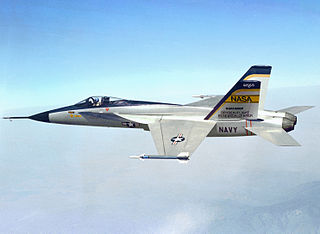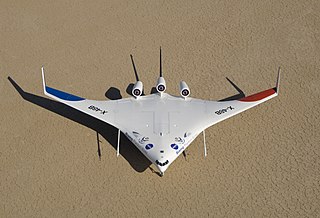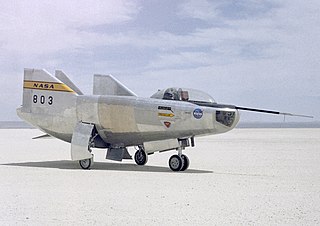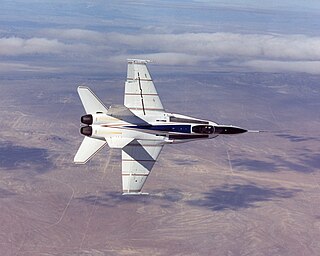
The McDonnell XF-88 Voodoo was a long-range, twinjet fighter aircraft with swept wings designed for the United States Air Force. Although it never entered production, its design was adapted for the subsequent supersonic F-101 Voodoo.

The McDonnell XF-85 Goblin is an American prototype fighter aircraft conceived during World War II by McDonnell Aircraft. It was intended to deploy from the bomb bay of the Convair B-36 bomber as a parasite fighter. The XF-85's intended role was to defend bombers from hostile interceptor aircraft, a need demonstrated during World War II. McDonnell built two prototypes before the Air Force (USAAF) terminated the program.

The Douglas D-558-2 Skyrocket is a rocket and jet-powered research supersonic aircraft built by the Douglas Aircraft Company for the United States Navy. On 20 November 1953, shortly before the 50th anniversary of powered flight, Scott Crossfield piloted the Skyrocket to Mach 2, or more than 1,290 mph (2076 km/h), the first time an aircraft had exceeded twice the speed of sound.

The Northrop YF-17 was a prototype lightweight fighter aircraft designed by Northrop aviation for the United States Air Force's Lightweight Fighter (LWF) technology evaluation program. The LWF was initiated because many in the fighter community believed that aircraft like the F-15 Eagle were too large and expensive for many combat roles. The YF-17 was the culmination of a long line of Northrop designs, beginning with the N-102 Fang in 1956, continuing through the F-5 family.

The Douglas F5D Skylancer is a development of the F4D Skyray jet fighter for the United States Navy. Starting out as the F4D-2N, an all-weather version of the Skyray, the design was soon modified to take full advantage of the extra thrust of the Pratt & Whitney J57 eventually fitted to the Skyray instead of the Westinghouse J40 originally planned.

The Northrop/McDonnell Douglas YF-23 is an American single-seat, twin-engine, supersonic stealth fighter aircraft technology demonstrator designed for the United States Air Force (USAF). The design was a finalist in the USAF's Advanced Tactical Fighter (ATF) competition, battling the Lockheed YF-22 for a production contract. Two YF-23 prototypes were built.

The Douglas X-3 Stiletto was a 1950s United States experimental jet aircraft with a slender fuselage and a long tapered nose, manufactured by the Douglas Aircraft Company. Its primary mission was to investigate the design features of an aircraft suitable for sustained supersonic speeds, which included the first use of titanium in major airframe components. Douglas designed the X-3 with the goal of a maximum speed of approximately 2,000 mph (3,200 km/h), but it was seriously underpowered for this purpose and could not even exceed Mach 1 in level flight. Although the research aircraft was a disappointment, Lockheed designers used data from the X-3 tests for the Lockheed F-104 Starfighter which used a similar trapezoidal wing design in a successful Mach 2 fighter.

The Northrop X-4 Bantam was a prototype small twinjet aircraft manufactured by Northrop Corporation in 1948. It had no horizontal tail surfaces, depending instead on combined elevator and aileron control surfaces for control in pitch and roll attitudes, almost exactly in the manner of the similar-format, rocket-powered Messerschmitt Me 163 of Nazi Germany's Luftwaffe. Some aerodynamicists had proposed that eliminating the horizontal tail would also do away with stability problems at fast speeds resulting from the interaction of supersonic shock waves from the wings and the horizontal stabilizers. The idea had merit, but the flight control systems of that time prevented the X-4 from achieving any success.

The Grumman X-29 was an American experimental aircraft that tested a forward-swept wing, canard control surfaces, and other novel aircraft technologies. The X-29 was developed by Grumman, and the two built were flown by NASA and the United States Air Force. The aerodynamic instability of the X-29's airframe required the use of computerized fly-by-wire control. Composite materials were used to control the aeroelastic divergent twisting experienced by forward-swept wings, and to reduce weight. The aircraft first flew in 1984, and two X-29s were flight tested through 1991.

The Rockwell-Messerschmitt-Bölkow-Blohm X-31 is an experimental jet fighter designed to test fighter thrust vectoring technology.

The Boeing X-32 is a concept demonstrator aircraft that was designed for the Joint Strike Fighter competition. It lost to the Lockheed Martin X-35 demonstrator, which was further developed into the Lockheed Martin F-35 Lightning II.

The Boeing YC-14 is a twinjet short take-off and landing (STOL) tactical military transport aircraft. It was Boeing's entrant into the United States Air Force's Advanced Medium STOL Transport (AMST) competition, which aimed to replace the Lockheed C-130 Hercules as the USAF's standard STOL tactical transport. Although both the YC-14 and the competing McDonnell Douglas YC-15 were successful, neither aircraft entered production. The AMST project was ended in 1979 and replaced by the C-X program.

The McDonnell Douglas YC-15 is a replaced prototype four-engine short take-off and landing (STOL) tactical transport. It was McDonnell Douglas' entrant into the United States Air Force's Advanced Medium STOL Transport (AMST) competition to replace the Lockheed C-130 Hercules as the USAF's standard STOL tactical transport. In the end, neither the YC-15 nor the Boeing YC-14 was ordered into production, although the YC-15's basic design would be used to form the successful McDonnell Douglas C-17 Globemaster III.

The Boeing X-48 is an American experimental unmanned aerial vehicle (UAV) built to investigate the characteristics of blended wing body (BWB) aircraft. Boeing designed the X-48 and two examples were built by Cranfield Aerospace in the UK. Boeing began flight testing the X-48B version for NASA in 2007. The X-48B was later modified into the X-48C version, which was flight tested from August 2012 to April 2013. Boeing and NASA plan to develop a larger BWB demonstrator.

The Boeing Bird of Prey was a black project aircraft, intended to demonstrate stealth technology. It was developed by McDonnell Douglas and Boeing in the 1990s. The company provided $67 million of funding for the project; it was a low-cost program compared to many other programs of similar scale. It developed technology and materials which would later be used on Boeing's X-45 unmanned combat air vehicle. As an internal project, this aircraft was not given an X-plane designation. There are no public plans to make this a production aircraft. It is characterized as a technology demonstrator.

The Northrop M2-F2 was a heavyweight lifting body based on studies at NASA's Ames and Langley research centers and built by the Northrop Corporation in 1966.

The Northrop M2-F3 was a heavyweight lifting body rebuilt from the Northrop M2-F2 after it crashed at the Dryden Flight Research Center in 1967. It was modified with an additional third vertical fin - centered between the tip fins - to improve control characteristics. The "M" refers to "manned" and "F" refers to "flight" version.

The McDonnell Douglas F-15 STOL/MTD is a modified F-15 Eagle. Developed as a technology demonstrator, the F-15 STOL/MTD carried out research for studying the effects of thrust vectoring and enhanced maneuverability. The aircraft used for the project was pre-production TF-15A (F-15B) No. 1, the first two-seat F-15 Eagle built by McDonnell Douglas, the sixth F-15 off the assembly line, and was the oldest F-15 flying up to its retirement. It was also used as the avionics testbed for the F-15E Strike Eagle program. The plane was on loan to NASA from the United States Air Force.

The Rockwell RPRV-870 HiMAT is an experimental remotely piloted aircraft that was produced for a NASA program to develop technologies for future fighter aircraft. Among the technologies explored were close-coupled canards, fully digital flight control, composite materials, remote piloting, synthetic vision systems, winglets, and others.

The X-53 Active Aeroelastic Wing (AAW) development program is a completed American research project that was undertaken jointly by the Air Force Research Laboratory (AFRL), Boeing Phantom Works and NASA's Dryden Flight Research Center, where the technology was flight tested on a modified McDonnell Douglas F/A-18 Hornet. Active Aeroelastic Wing Technology is a technology that integrates wing aerodynamics, controls, and structure to harness and control wing aeroelastic twist at high speeds and dynamic pressures. By using multiple leading and trailing edge controls like "aerodynamic tabs", subtle amounts of aeroelastic twist can be controlled to provide large amounts of wing control power, while minimizing maneuver air loads at high wing strain conditions or aerodynamic drag at low wing strain conditions. This program was the first full-scale proof of AAW technology.






























